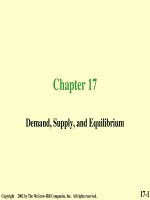Lecture Economics (6/e): Chapter 21 - Stephen L. Slavin
Bạn đang xem bản rút gọn của tài liệu. Xem và tải ngay bản đầy đủ của tài liệu tại đây (280.99 KB, 28 trang )
Chapter 21
Profit Maximization
Copyright 2002 by The McGrawHill Companies, Inc. All rights reserved.
211
Chapter Objectives
• Marginal Revenue
• Profit maximization and loss
minimization
• The shortrun supply curve
• The longrun supply curve
• The shutdown and breakeven points
• Economic efficiency
Copyright 2002 by The McGrawHill Companies, Inc. All rights reserved.
212
Graphing Demand & Marginal Revenue
Total Revenue is price X output
Marginal revenue is the increase in total revenue when
output sold goes up by one unit
Output Price Total Revenue Marginal
Revenue
1
$5
$ 5
$5
2
5
10
5
3
5
15
5
4
5
20
5
5
5
25
5
6
5
30
Copyright 2002 by The McGrawHill Companies, Inc. All rights reserved.
5
213
Graphing Demand & Marginal Revenue
Output Price Total Revenue Marginal Revenue
6
1
$5
$ 5
$5
2
5
10
5
5
3
5
15
5
4
4
5
20
5
3
5
5
25
5
2
6
5
30
5
1
D,MR
0
0
Copyright 2002 by The McGrawHill Companies, Inc. All rights reserved.
1
2
3
4
Output
5
6
214
Profit Maximization and Loss
Minimization
Output Price TR MR TC ATC MC Total Profits
1 1 $200 $200 $200 $500 $500 $100 $300
1 2 200 400 200 550 275 50 150
1 3 200 600 200 610 203 60 10
1 4 200 800 200 700 175 90 100
1 5 200 1000 200 830 166 130 170
1 6 200 1200 200 1000 167 170 200
1 7 200 1400 200 1205 172 205 195
Profit Maximization Point: MC = MR
Copyright 2002 by The McGrawHill Companies, Inc. All rights reserved.
215
Profit Maximization and Loss Minimization
Output Price TR MR TC ATC MC Total Profits
1 1 $200 $200 $200 $500 $500 $100 $300
1 2 200 400 200 550 275 50 150
1 3 200 600 200 610 203 60 10
1 4 200 800 200 700 175 90 100
1 5 200 1000 200 830 166 130 170
1 6 200 1200 200 1000 167 170 200
1 7 200 1400 200 1205 172 205 195
Profit Maximization Point: MC = MR
This occurs somewhere between 6 and 7 units.
We are assuming output can be produced in tenths of a unit
Copyright 2002 by The McGrawHill Companies, Inc. All rights reserved.
216
Profit Maximization and Loss Minimization
Output MR MC
1 $200 $100
2 200 50
3 200 60
4 200 90
5 200 130
6 200 170
7 200 205
Profit Maximization Point: MC = MR
500
400
300
D,MR
200
MC
ATC
100
0
0
1
2
3
4
Output
5
6
7
The most profitable output is where the MC curve crosses the D, MR curve. This
occurs at an output of 6.7 units
Copyright 2002 by The McGrawHill Companies, Inc. All rights reserved.
217
Profit Maximization and Loss Minimization
Total Profit=(PriceATC) X Output
TP=Total Profit; P=Price
TP=(PATC) X Output
TP=$200$170) X 6.7
TP=$30 X 6.7
TP=$201
500
400
300
Price is $200
D,MR
200
MC
ATC
ATC is $170
100
Profit Maximization Point: MC = MR
0
0
1
2
3
4
Output
5
6
7
The most profitable output is where the MC curve crosses the D, MR curve. This
occurs at an output of 6.7 units
Copyright 2002 by The McGrawHill Companies, Inc. All rights reserved.
218
Making Sure We Are Maximizing Profit
Output
Profit
6.0. . . . . . . . . . . . . $200
If you calculated the total profit at
6.1
every level of output (6.1 through 6.9)
6.2
you would find that the output level of
6.3 6.7 units would provide you with the
greatest level of profit.
6.4
This is the output level where
MC=MR
6.5
6.6
6.7 . . . . . . . . . . . . . . 201 < Best that we can do!
6.8
6.9
7.0 . . . . . . . . . . . . . . 195
Copyright 2002 by The McGrawHill Companies, Inc. All rights reserved.
219
Profit Maximization and Loss Minimization
1,500
TP = (PATC) X Output
1,400
TP = $450$533) X 5.2
TP = $83 X 5.2
TP = $431.60
1,300
1,200
1,100
In this particular instance, losses
were minimized
Profit Maximization Point: MC = MR
1,000
900
800
700
600
ATC is $533
Price is $450
500
400
The most profitable output is where the
MC curve crosses the D, MR curve. This
occurs at an output of about 5.2 units
300
200
100
0
1
2
Copyright 2002 by The McGrawHill Companies, Inc. All rights reserved.
3
4
5
6
7
2110
Making Sure We Are Minimizing Losses
Output
Profit
5.0
$450.00
5.1
5.2
431.60 <Best we can do!
5.3
If you calculated the total profit at every level
5.4 of output (5.1 through 5.9) you would find
that the output level of 5.2 units would
5.5
provide you with the smallest possible loss.
5.6
This is the output level where MC=MR
5.7
5.8
5.9
6.0 700.00
Copyright 2002 by The McGrawHill Companies, Inc. All rights reserved.
2111
Producing Exactly at the Output Level Where
MC = MR Enables Us to Maximize Total Profits
(or Minimize Total Losses)
• MR is the additional revenue from selling one
more unit of output
• MC is the additional cost of producing one
more unit of output
• We keep adding to output as long as MR
exceeds MC
– If we stop short of this point, we would not
maximize our profit
• We stop adding to output when MR = MC
– If we continued to add output MC would exceed MR
and this would diminish our profits
2112
Copyright 2002 by The McGrawHill Companies, Inc. All rights reserved.
The ShortRun and LongRun Supply Curves
The ShortRun Supply Curve
A firm will always produce where MC equals MR
A firm will operate in the shortrun if sales (TR) are greater than
variable cost (VC) [ Remember TR = Price X Output]
A firm will shut down if variable cost (VC) are greater than
sales (TR) [Remember, sales and TR are the same]
Therefore, a firm will shut down if VC is greater TR or if VC are
greater than Price X Output
Copyright 2002 by The McGrawHill Companies, Inc. All rights reserved.
2113
A firm will shut down if VC > TR or if VC > Price X Output
A firm will shut down if
VC > Price X Output
Let’s divide both side of the above equation by Output
VC > Price X Output
Output
Output
Copyright 2002 by The McGrawHill Companies, Inc. All rights reserved.
2114
A firm will shut down if VC > TR or if VC > Price X Output
A firm will shut down if
VC > Price X Output
Let’s divide both side of the above equation by Output
VC > Price X Output
Output
Output
AVC > Price
Copyright 2002 by The McGrawHill Companies, Inc. All rights reserved.
2115
A firm will shut down if VC > TR or if VC > Price X Output
A firm will shut down if
VC > Price X Output
Let’s divide both sides of the above equation by Output
VC > Price X Output
Output
Output
AVC > Price
Copyright 2002 by The McGrawHill Companies, Inc. All rights reserved.
2116
In the shortrun a firm will shut down if the
AVC is greater than the price
Alternatively
In the shortrun a firm will operate if the
price is greater than the AVC
Copyright 2002 by The McGrawHill Companies, Inc. All rights reserved.
2117
Cost Curves
• At any given time, a business firm will have a
certain set of cost curves: AVC, ATC, and MC.
– These curves are determined mainly by the firm’s
capital stock – its plant and equipment
• Over time these curves can change, but at any
given time they’re fixed
• At any given time, we can assume the MC curve
doesn’t change
Copyright 2002 by The McGrawHill Companies, Inc. All rights reserved.
2118
Review
• MC must equal MR
• MC stays the same
• MR can change to any value because
whenever price changes we have an new
MR line
• When the price changes MR changes and
will equal MC at some other point on the
MC curve
Copyright 2002 by The McGrawHill Companies, Inc. All rights reserved.
2119
Derivation of a Firm’s ShortRun & Long
Run Supply Curve
The firm’s shortrun supply
curve begins at the shut
down point and runs all the
way up the MC curve
The firm’s longrun supply
curve begins at the break
even point and runs all the
way up the MC curve
Minimum point on the ATC
60
MC
55
50
45
40
35
30
25
ATC
20
Break-even point
AVC
15
10
Shut-down point
5
0
Minimum point on the AVC
0
1
2
3
4
Copyright 2002 by The McGrawHill Companies, Inc. All rights reserved.
5
6
7
8
9
10
11
Output
2120
Four Rules
• In the short run
– If the price is below the shutdown point, the firm
will shut down
– If the price is above the shutdown point, the firm
will operate
• In the long run
– If the price is below the breakeven point, the firm
will go out of business
– If the price is above the breakeven point, the firm
will stay in business
Copyright 2002 by The McGrawHill Companies, Inc. All rights reserved.
2121
The ShutDown and BreakEven Points
200
What is the lowest price the
firm will accept in the short
run?
Answer: $101
180
MC
160
Break-even
point
140
ATC
D,MR
Output AVC ATC Total Profits
1 $150 $250 $120
2 120 170
80 3 106.67 140
30 4 102.50 127.50
+ 10 5 106 126
+ 20 6 116.67 133.33
20
120
AVC
100
Shut-down point
80
0
1
2
Copyright 2002 by The McGrawHill Companies, Inc. All rights reserved.
3
4
Output
5
6
7
2122
The ShutDown and BreakEven Points
200
What is the lowest price the
firm will accept in the long
run?
180
MC
160
Answer: $125.50
Break-even
point
140
ATC
D,MR
Output AVC ATC Total Profits
1 $150 $250 $120
2 120 170
80 3 106.67 140
30 4 102.50 127.50
+ 10 5 106 126
+ 20 6 116.67 133.33
20
120
AVC
100
Shut-down point
80
0
1
2
Copyright 2002 by The McGrawHill Companies, Inc. All rights reserved.
3
4
Output
5
6
7
2123
The ShutDown and BreakEven Points
Calculate Total Profit
TP = (P – ATC) X Output
TP = ($130 – $126) X 5.25
TP = 4 X 5.25
TP = $21
200
180
MC
160
Break-even
point
140
Price is 130
ATC
D,MR
120
AVC
ATC is 126
100
Shut-down point
80
0
1
2
3
4
Output
5
6
7
Output is 5.25
Copyright 2002 by The McGrawHill Companies, Inc. All rights reserved.
2124
The ShutDown and BreakEven Points
200
How much will the firm’s
output be in the short run and
the long run if the price is
$170?
180
160
The firm will maximize profits
at an output of 6
140
In both the short run and the
long run the output will be six
because that is where MC = MR
100
D, MR
MC
Break-even
point
ATC
D,MR
120
AVC
Shut-down point
80
0
1
2
Copyright 2002 by The McGrawHill Companies, Inc. All rights reserved.
3
4
Output
5
6
7
2125









